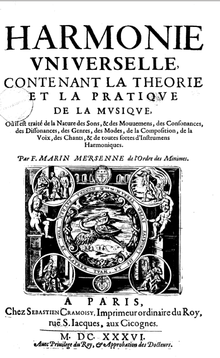Harmonie universelle: Difference between revisions
Translate broken template |
SimLibrarian (talk | contribs) mNo edit summary Tags: Mobile edit Mobile app edit iOS app edit |
||
| (16 intermediate revisions by 7 users not shown) | |||
| Line 1: | Line 1: | ||
{{Short description|1636 work by Marin Mersenne}} |
|||
<!-- Don't mess with this line! -->{{New unreviewed article|date=April 2016}} |
|||
{{unreferenced|date=April 2016}} |
|||
<!-- Write your article below this line --> |
|||
| ⚫ | |||
{{art-stub}} |
|||
{{Italic title}} |
|||
| ⚫ | |||
|name = Harmonie universelle, contenant la théorie et la pratique de la musique |
|name = Harmonie universelle, contenant la théorie et la pratique de la musique |
||
|image = Marin Mersenne - Harmonie universelle 1636 (page de titre).png |
|image = Marin Mersenne - Harmonie universelle 1636 (page de titre).png |
||
| Line 11: | Line 7: | ||
|alt = Title page of Harmonie universelle |
|alt = Title page of Harmonie universelle |
||
|author = [[Marin Mersenne]] |
|author = [[Marin Mersenne]] |
||
|country = France |
|country = [[Kingdom of France]] |
||
|language = French |
|language = French |
||
|country = [[France]] |
|||
|published = 1636 |
|published = 1636 |
||
|editor = Sebastien Cramoisy, Pierre I Ballard et Richard Charlemagne |
|||
|pages = 800 |
|pages = 800 |
||
}} |
}} |
||
| ⚫ | |||
| ⚫ | |||
| ⚫ | |||
==Content== |
|||
| ⚫ | |||
The title page specifies the scope of the topics covered by the book including the nature of sounds, movements, consonance, dissonance, genres, modes of composition, voice, singing, and all kinds of harmonic instruments. This monumental treatise is abundant in illustrations (including musical engravings), and in systematic tables. It also remains the only source of certain musical works from [[Jacques Mauduit]], [[Eustache Du Caurroy]], Antoine de Sewn, or Pierre de La Barre in particular. |
|||
==Editions== |
|||
* Mersenne, Marin (1636). [https://gallica.bnf.fr/ark:/12148/bpt6k5471093v ''Harmonie universelle'']. |
|||
==See also== |
|||
* [[Mersenne's laws]] |
|||
<!-- |
|||
| ⚫ | |||
{{Reflist}}--> |
|||
{{Authority control}} |
|||
[[Category:Music books]] |
|||
[[Category:French-language books]] |
|||
[[Category:1636 books]] |
|||
| ⚫ | |||
{{reflist}} |
|||
<!-- After listing your sources please cite them using inline citations and place them after the information they cite. Please see http://en.wikipedia.org/wiki/Wikipedia:REFB for instructions on how to add citations. --> |
|||
* |
|||
* |
|||
* |
|||
* |
|||
{{music-publication-stub}} |
|||
Content in this edit is translated from the existing French Wikipedia article at [[:fr:Harmonie_universelle]]; see its history for attribution. |
|||
Latest revision as of 06:38, 22 June 2022
 Title page | |
| Author | Marin Mersenne |
|---|---|
| Country | Kingdom of France |
| Language | French |
| Published | 1636 |
| Pages | 800 |
Harmonie universelle ("Universal Harmony"; complete title: Harmonie universelle, contenant la théorie et la pratique de la musique) is a work by Marin Mersenne, published in Paris in 1636. It represented the sum of musical knowledge during his lifetime.
This was a major work since it represented the most complete description of music theory near the middle of the 17th century in France. It covers all aspects including theoretical, practical, stylistic, organological, mathematical, acoustical, and theological.
Content[edit]
The title page specifies the scope of the topics covered by the book including the nature of sounds, movements, consonance, dissonance, genres, modes of composition, voice, singing, and all kinds of harmonic instruments. This monumental treatise is abundant in illustrations (including musical engravings), and in systematic tables. It also remains the only source of certain musical works from Jacques Mauduit, Eustache Du Caurroy, Antoine de Sewn, or Pierre de La Barre in particular.
Editions[edit]
- Mersenne, Marin (1636). Harmonie universelle.
See also[edit]
